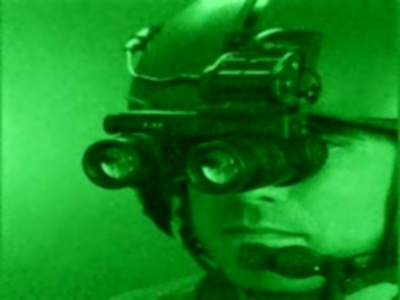Night vision: Second eyes
The collection, amplification and conversion of infrared light into images is the mechanism of operation of the night vision device (night vision goggles), helping people see things in the dark.
To turn infrared light (naked eyes) into a picture that people can see clearly, night vision uses image enhancement or thermal imaging.

Night vision goggles are widely used in many different areas.(Photo: Softpedia)
Enhance photos
With image enhancement techniques, night vision goggles collect small amounts of light emitted from the environment, such as near-infrared light, then magnify it in a visible light spectrum.
Infrared light is a form of electromagnetic radiation, which has a much longer wavelength than visible light with the naked eye. Infrared spectral band is divided into 3 areas: near infrared (located beyond the red area in the visible spectrum), medium infrared (with wavelength of 1.3 to 3 micrometers) and heat Infrared (wavelength from 3 to 30 micrometers).
Near-infrared light emitted from the environment is gathered by a lens and focuses on the image amplifier tube. Next, a photocathode transforms this light into an electronic stream. When passing through a plate of plates with plates that are extremely small, the electronic quantity of this flow will be increased many times for the purpose of signal amplification. The other side of the glass has a screen coated with phosphor to collect the emitted electrons and turn them into visible light to form images. The resulting image is always monochrome and that color depends on the type of phosphor used for coating the screen.
The glass enhances the simple type image with 1 common lens, 1 photo magnification tube and 1 eye lens (ocular lens).
Thermal imaging
More complex than a photo magnifying glass, the thermal imaging glass gathers and magnifies infrared light in a much lower range of electromagnetic spectra, such as infrared thermal light emitted by hot objects.
Infrared heat emitted from the environment is gathered and focused on phased array antennas through the support of a lens. This network will create a heat graph in the form of light shining on it, then convert the light into an electrical impulse chain. This impulse chain is sent to a signal processing unit that turns the received signal into image data for display.
Most of these night vision goggles are capable of producing images with a frame rate of 30 frames per second and can detect temperatures from -20 ° C to 2,000 ° C.
According to experts, night vision goggles have a wide range of applications, especially in the areas of security, military, legal protection and monitoring - supervision.
- Why are the eyes of animals glowing under the lights?
- The reasons why your eyes are blurred
- Discover special glasses that help American soldiers see through the night
- American developed contact lenses that are capable of night vision
- How far can human eyes be?
- Why do animals with large eyes run faster?
- 9 abnormal signs of eye health problems
- Why do cats see at night but daytime sightings?
- Mobile phone look through dark night
- Night vision goggles can help American soldiers detect mines
- Are there restrictions for the eyes?
- 7 things that are harmful to the eyes
 Daily use inventions come from universities
Daily use inventions come from universities Special weight loss device helps prevent appetite
Special weight loss device helps prevent appetite 8 inventors were killed by their own inventions
8 inventors were killed by their own inventions Iran invented a motor car powered by water
Iran invented a motor car powered by water Mysterious light guides sailors at sea
Mysterious light guides sailors at sea  9 billion light years away, 'space hole' facing Earthlings
9 billion light years away, 'space hole' facing Earthlings  Simulating Einstein's formula, scientists prove that light can create matter
Simulating Einstein's formula, scientists prove that light can create matter  How do animals see the world?
How do animals see the world?  How do real life invisibility cloaks work?
How do real life invisibility cloaks work?  Double quasars travel through 10 billion years to Earth, about to merge into a monster
Double quasars travel through 10 billion years to Earth, about to merge into a monster 